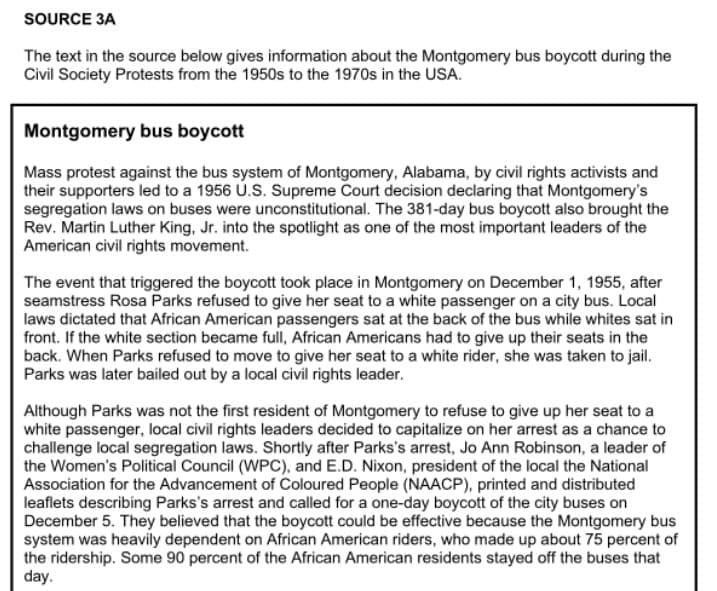3.1.4 Explain why the boycott could have been especially effective in a place like Montgomery, Alabama.
3.1.4 Explain why the boycott could have been especially effective in a place like Montgomery, Alabama.
Related questions
Question

Transcribed Image Text:SOURCE 3A
The text in the source below gives information about the Montgomery bus boycott during the
Civil Society Protests from the 1950s to the 1970s in the USA.
Montgomery bus boycott
Mass protest against the bus system of Montgomery, Alabama, by civil rights activists and
their supporters led to a 1956 U.S. Supreme Court decision declaring that Montgomery's
segregation laws on buses were unconstitutional. The 381-day bus boycott also brought the
Rev. Martin Luther King, Jr. into the spotlight as one of the most important leaders of the
American civil rights movement.
The event that triggered the boycott took place in Montgomery on December 1, 1955, after
seamstress Rosa Parks refused to give her seat to a white passenger on a city bus. Local
laws dictated that African American passengers sat at the back of the bus while whites sat in
front. If the white section became full, African Americans had to give up their seats in the
back. When Parks refused to move to give her seat to a white rider, she was taken to jail.
Parks was later bailed out by a local civil rights leader.
Although Parks was not the first resident of Montgomery to refuse to give up her seat to a
white passenger, local civil rights leaders decided to capitalize on her arrest as a chance to
challenge local segregation laws. Shortly after Parks's arrest, Jo Ann Robinson, a leader of
the Women's Political Council (WPC), and E.D. Nixon, president of the local the National
Association for the Advancement of Coloured People (NAACP), printed and distributed
leaflets describing Parks's arrest and called for a one-day boycott of the city buses on
December 5. They believed that the boycott could be effective because the Montgomery bus
system was heavily dependent on African American riders, who made up about 75 percent of
the ridership. Some 90 percent of the African American residents stayed off the buses that
day.

Transcribed Image Text:3.1.4 Explain why the boycott could have been especially effective in a
place like Montgomery, Alabama.
Expert Solution
This question has been solved!
Explore an expertly crafted, step-by-step solution for a thorough understanding of key concepts.
This is a popular solution!
Trending now
This is a popular solution!
Step by step
Solved in 2 steps
